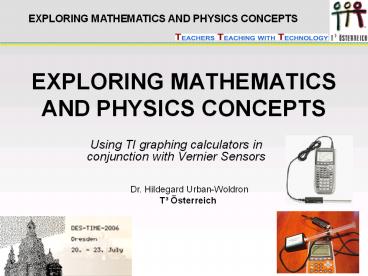EXPLORING MATHEMATICS AND PHYSICS CONCEPTS - PowerPoint PPT Presentation
1 / 23
Title:
EXPLORING MATHEMATICS AND PHYSICS CONCEPTS
Description:
EXPLORING MATHEMATICS AND PHYSICS CONCEPTS EXPLORING MATHEMATICS AND PHYSICS CONCEPTS Using TI graphing calculators in conjunction with Vernier Sensors – PowerPoint PPT presentation
Number of Views:283
Avg rating:3.0/5.0
Title: EXPLORING MATHEMATICS AND PHYSICS CONCEPTS
1
EXPLORING MATHEMATICS AND PHYSICS CONCEPTS
EXPLORING MATHEMATICS AND PHYSICS CONCEPTS
- Using TI graphing calculators in conjunction with
Vernier Sensors
Dr. Hildegard Urban-Woldron T³ Österreich
2
EXPLORING MATHEMATICS AND PHYSICS CONCEPTS
- INTRODUCTION
- RESEARCH QUESTIONS AND THEIR METHODICAL BASIS
- TASKS AND PRACTICAL EXPERIENCES IN THE CLASSROOM
- EVALUATION, ASSESSMENT AND DISCUSSION
3
INTRODUCTION
- APPS - powerful technological tools
- explore, discover and extend mathematical ideas
- GC - IT-platform
- Vernier sensors for collecting various data
- GC for analyzing and building models
- impact of new technologies
4
RESEARCH QUESTIONS AND THEIR METHODICAL BASIS
- software tools - students mathematical thinking
- educational potential of connecting Mathematics
and Physics - effects of analyzing real world data
- ask own questions and explore them
- gain insight into the individual students
perspective
5
RESEARCH QUESTIONS AND THEIR METHODICAL BASIS
- Students behaviour in the learning environment
- analyze the data both algebraically and
graphically - associate these relationships with
mathematical functions - Do the offered tasks support reactive, active or
pro-active learning? - The impact of the teachers behaviour on the
learning efficiency of the student
6
TASKS AND PRACTICAL EXPERIENCES IN THE CLASSROOM
- EASYTEMP, EASYLINK, CBR 2
- in combination with the GC
- offer a learning environment for
- experimenting, modelling, analyzing and
visualizing real world data - Students are asked
- to explore the situations
- make conjectures and
- finally prove them
7
ACTIVITY 1 THE BOUNCING BALL
- measure the movement of the ball
- describe it as a function of time
- and derive the gravity law
- time-distance graphs are parabolic functions
- The maximum height decreases from bounce to
bounce
8
ACTIVITY 1 THE BOUNCING BALL
- highest speed of the ball
- acceleration during falling
- model to describe the height of the ball for a
particular bounce - total distance of the ball
- velocity change as the ball rises and falls
- What affects the shape of the graph of both the
height and the velocity?
9
ACTIVITY 1 THE BOUNCING BALL
10
ACTIVITY 1 THE BOUNCING BALL
11
ACTIVITY 1 THE BOUNCING BALL
12
ACTIVITY 2 AIR UNDER PRESSURE BOYLES LAW
13
ACTIVITY 2 AIR UNDER PRESSURE BOYLES LAW
14
ACTIVITY 2 AIR UNDER PRESSURE BOYLES LAW
- What kind of relationship exists between volume
and pressure? - A quadratic function (parabola as graph)?
- An exponential function?
- A power function or a hyperbolic function?
15
ACTIVITY 2 AIR UNDER PRESSURE BOYLES LAW
for 20 ml the pressure was almost 102 kPa
16
ACTIVITY 3 NEWTONS LAW OF COOLING
What determines the cooling process?
17
ACTIVITY 3 NEWTONS LAW OF COOLING
?
?
18
ACTIVITY 3 NEWTONS LAW OF COOLING
19
ACTIVITY 3 NEWTONS LAW OF COOLING
20
ACTIVITY 3 NEWTONS LAW OF COOLING
Newtons law of cooling
or
Students try to fit the temperature functions
above to the actually measured curve by adjusting
the parameters k and a.
21
ACTIVITY 3 NEWTONS LAW OF COOLING
Extensions research questions
- Has the starting temperature of the hot water any
impact on the value obtained for a? - What could you do to your experimental apparatus
to decrease the value of k in another run? What
quantity does k measure? - If your starting temperature difference is cut in
half, does it take half as long to get 1C above
room temperature? Why or why not does it take
half as long?
22
EVALUATION, ASSESSMENT AND DISCUSSION
- simple questions motivated
- to a rich discourse and activity in the classroom
- and further exploration
- lessons involved multiple stages of investigation
- prediction, testing, rejection or extension of
hypotheses - discovering and exploring the underlying
mathematics - making generalizations and proving results
23
EVALUATION, ASSESSMENT AND DISCUSSION
- technology in the classroom especially supports
the active, self-controlled and self-motivated
student - challenge for the teacher
- embed technology tools in the general syllabus
- and into the class room
- substantial change in the learning process
- active, individual construction of knowledge
- guidance - room for individual exploration

